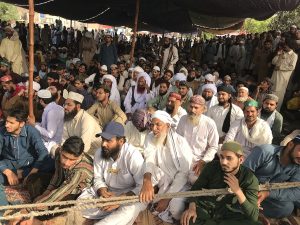In late September, India banned an Islamist group, the Popular Front of India (PFI). A little over a month later, Pakistan retracted the proscription of the neo-Barelvi radical outfit, the Tehreek-e-Labbaik Pakistan (TLP). The two diametrically opposite policy responses bring into sharp focus that bans against hybrid threat groups in a fluid threat environment are reductive and could possibly do more harm than good.
To understand hybrid radical groups located at the intersection of violent and non-violent extremism, existing security-centric counter-extremism approaches in South Asia should be replaced with more nuanced interdisciplinary frameworks.
Terrorism is a label of convenience, which has been abused both by state and non-state actors, particularly in the South Asian context. The lack of a consensual definition has left a lot of grey space for states to exploit. Terrorism bans carry an element of social and political stigmatization. For states, it is convenient to proscribe dissenting non-state groups practicing violence under counterterrorism laws. However, it amounts to sweeping challenging policy questions under the carpet and shying away from addressing the root causes. The illegality that comes with terrorism bans pushes even genuine grievances, violent tactics notwithstanding, out of the mainstream discourse.
All forms of anti-state violence are not terrorism. Likewise, all non-state actors engaging in anti-state violence are not “terrorists” and those using terrorism as a tactic could be insurgent or radical groups as well. There are, for instance, radical groups that do not condone the systematic use of violence, but their individual members engage in lone-actor terrorism, complicating matters.
This is where an interdisciplinary approach that draws on multiple typologies of hybrid threat groups, in addition to terrorism, becomes important. Only looking at them through the narrow lens of terrorism blinds policymakers to other aspects of the intangible threats they pose. Furthermore, genuine grievances encouraging or compelling certain societal sections to engage in anti-state violence should be thoroughly studied and addressed from a long-term perspective.
A case in point is Pakistan’s knee-jerk decision to proscribe and then withdraw the terrorism ban on the TLP. As a neo-Barelvi political outfit, TLP has politicized the Barelvi identity in Pakistan along narrow sectarian lines around the issue of blasphemy. The group gained greater traction against the backdrop of insulting caricatures of the Prophet Muhammad by the French satirical magazine, Charlie Hebdo.
TLP held large-scale protest rallies across Pakistan in 2016 and 2017 and quickly gained enough political capital to contest the 2018 elections. It also gained notoriety for its disruptive ability to shut down Pakistan’s major cities in a matter of hours. In 2021, when French President Emanuel Macron supported Charlie Hebdo’s decision to republish the controversial cartoons, the TLP demanded the expulsion of the French Ambassador from Islamabad and threatened to lay siege to the Pakistani capital through a long march.
Perturbed by its agitational politics and radical narrative, the state banned the TLP under terrorism laws. TLP’s leader Saad Hussain Rizvi was also arrested in the hope that his detention will weaken the group. However, the group’s street pressure, given its resilient social base, mounted on the state. Eventually, the state withdrew the terrorism ban and released Saad and his other associates after it signed a deal with the TLP.
Typologically, TLP is located at the intersection of violent and non-violent extremism. The group neither encourages systematic or organized violence to achieve its stated goals nor discourages incidents of lone-actor terrorism carried out by its members against alleged blasphemers. Therefore, only looking at TLP from a narrow terrorism lens is problematic. While the self-initiated acts of lone-actor terrorism need to be tackled kinetically, the more challenging aspect is the hate speech that facilitates such vigilante killings. This is where non-kinetic aspects of counter-extremism involving alternative narratives against extremist ideologies become important. As long as its ideological narrative thrives, people will continue to take the law into their hands against alleged blasphemers whether TLP remains banned or not.
Likewise, India slapped a five-year terrorism ban on the PFI, a neo-radical Islamist group, in September for its alleged links with terrorist groups, activism aimed at creating Muslim-Hindu animosity and creating social unrest. It is important to mention that some PFI members have engaged in individual acts of lone-actor terrorism as well. Once again, like TLP, PFI is a hybrid group, using a combination of religious activism and militancy.
Hence, a ban alone is not sufficient to tackle the hybrid threat that it poses. Its radical ideology with a wide social base in Kerala and Karnataka would keep PFI relevant among its constituents, particularly when the majoritarian Hindutva forces continue to push India’s religious minorities, especially the Muslim community, to the margins of the social and political mainstream.
In South Asia’s fluid threat environment, entities like TLP and PFI pose hybrid threats to Pakistani and Indian polities, respectively. Therefore, rather than banning such entities by looking at them only through a narrow lens of terrorism, a more interdisciplinary approach that cuts through their ideological narratives and takes into account the genuine grievances underpinning such radical activism offers a more holistic way forward for more nuanced policymaking.

































